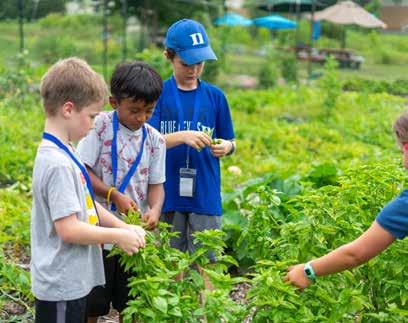
4 minute read
CELEBRATING A DECADE OF OUTDOOR LEARNING
urham Public Schools’ crown jewel of outdoor education celebrates a milestone this year and will commemorate 10 years of learning, exploration, and hands-on experiences for Durham students.
The peaceful 30-acre farm, forest, meadow, and aquatic learning center is appropriatly nestled next door to Eno Valley Elementary, Carrington Middle, and Northern High schools for tranquil instruction.
“It’s welcoming, where people feel at peace.
It’s a transformative space for people’s emotional wellbeing, a good healing space,” said Ashley Meredith, the Hub Farm’s program manager.
Meredith has led the program for half of its 10 years, starting with the program as an AmeriCorps member immediately after graduating from college. She’s had the privilege of helping to expand its reach through programs and physical improvements.
“I think an opportunity like this is unparalleled for lots of students. It’s a really good way to level the playing field in terms of experiences. It’s really important for equity,” said Meredith.
Former Eno Valley Elementary School Principal Jason Jowers supports that belief.
“Outdoor learning provides students an opportunity to acquire background knowledge in topics they normally would have no exposure to. This is critical during EOG testing where literacy passages pull on the background knowledge of students,” he said.
Schools bring their students for field trips to the farm for exposure to wildlife, farm animals, and to learn about environmental stewardship, health and nutrition, and career development. The farm has quite a following on social media — Instagram and Twitter — and the newsletter has 1,400 subscribers.
While one can quantify the reasons for the farm’s utility, Northern High School Culinary Arts instructor Peter Brodsky says the resource is immeasurable.
“The impact goes so far beyond culinary or agriculture classes and really extends to everyone that is able to engage with the farm as a resource and incorporate the space into their instruction,” he said.
Meredith has high hopes for the farm’s impact.
“It’s a place that holds so much potential. There are endless opportunities to continue to build on it whether it’s through programming or physically. I hope it continues to become a bigger, rock-solid piece of the community,” said Meredith.
It is undoubtedly a meaningful resource for the district’s teaching and learning communities, especially at Eno Valley Elementary, according to Jowers.
“The Hub Farm is intentional about making sure they provide lessons that correlate to what is happening in the classroom. It is not just a set curriculum that they are unwilling to adjust. They are open to collaboration and want to do what is in the best interest of student achievement,” he said.
Brodsky can attest to successful collaboration.
When asked how he utilizes the farm, he said, “In so many ways! The Hub Farm is an incredible resource to teach students about modern agriculture, historical agriculture, organic farming, and so much more. Students are able to engage in real time with products throughout their growing season, from seed to harvest. They are able to see the critical role of honeybees and other pollinators in our food systems.
Students can also interact with livestock being raised in humane and ethical conditions, and explore how that contrasts with large scale industrial farming.”
Brodsky says he’s also seen English students writing poetry at the pond, outdoor education students in kayaks, and math students calculating the height and circumference of trees. “From K-12 in all aspects of our instruction there is no class that wouldn’t benefit from hands-on outdoor learning that is so readily available at the farm,” he said.
Brodsky says every student enrolled in his culinary arts courses visits the Hub Farm at least once a month or more. Students in higher level culinary courses have the opportunity to plan, plant, manage, and harvest crops at the Hub Farm for use in the catering menus they develop throughout the semester.
Learning at the Hub Farm is fun, said Brodsky. When fall semester starts, the farm is perfect for teaching a variety of preservation techniques.
“Every year we make a variety of jams and jellies, including annual batches of our famous pepper jelly,” he said.
The class also pickles peppers, okra, green beans, tomatoes, cucumbers, radishes, and carrots. They make sauces and garnishes with the fresh herbs from the farm and baked goods using the chicken and duck eggs. Students have even produced full meals entirely with products grown and raised at the Hub Farm, including working with some ducks that were processed at the farm to produce pate, confit, sausage, stock, and more.
Fun Facts About The Hub Farm
• In the 2021-2022 school year, 2,514 students visited the Hub Farm, more than 2,000 pounds of produce were shared with the community, and the first summer camp (summer 2021) was hosted with 96 students from 20 schools.

• More than 20,000 students have visited the Hub Farm.
• The estimated number of volunteers is more than 1,700.










